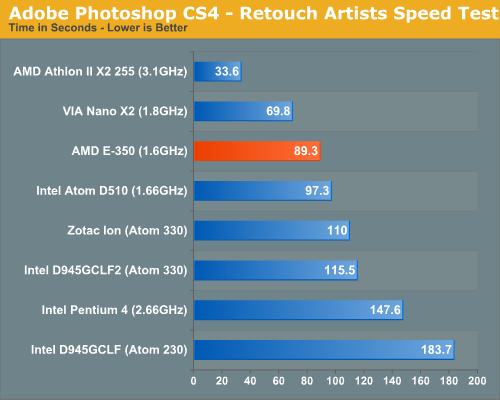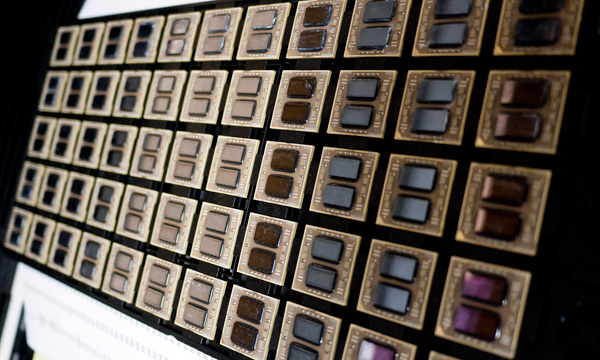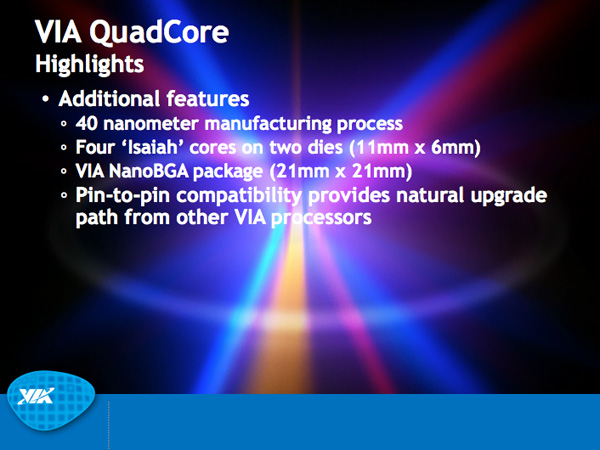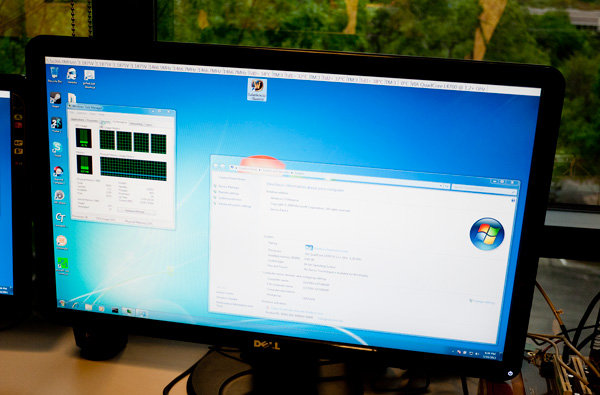VIA's QuadCore: Nano Gets Bigger
by Anand Lal Shimpi on May 12, 2011 3:01 AM ESTTwo days ago I flew out to VIA's Centaur headquarters in Austin, Texas to be briefed on a new CPU. When I wrote about VIA's Dual-Core Nano I expected the next time we heard from VIA about CPUs to be about its next-generation microprocessor architecture. While Nano still holds a performance advantage over Atom and Bobcat, it's still missing a number of key architectural innovations that both Intel and AMD have adopted in their current generation hardware (e.g. GPU integration, power gating).

VIA's dual-core Nano, faster than AMD's E-350 and Intel's Atom
Much to my surprise, the meeting wasn't about VIA's next-generation microprocessor architecture but rather the last hurrah for Nano: a quad-core version simply called the VIA QuadCore.
VIA's QuadCore architecture is nothing too surprising. At a high level the chip is composed of two dual-core die connected by a shared 1333MHz FSB, very similar to the old dual-core Pentium D processors. Each dual-core die has two 1MB independent L2 caches, for a total of 4MB of L2 on-package.

VIA's QuadCore, in production today
Going a little deeper there's an AMD-like 64KB L1 instruction and 64KB L1 data cache per core. The Nano is of course fully 64-bit x86 compatible, supporting up to SSE4. Each core is a 3-issue out-of-order design, giving it a general throughput and performance advantage over Intel's Atom and AMD's Bobcat. Remember that Atom is a 2-issue in-order architecture and Bobcat is 2-issue out-of-order. The wider front end for Nano gives VIA the ability to perform well in more complex workloads.

In the past power consumption has been an issue for VIA's Nano, however the QuadCore is built on a 40nm process which helps reel in power consumption. At 1.2GHz, VIA's QuadCore still carries a 27W TDP. Add another 5W for the integrated graphics chipset and you're talking about 32W, nearly double of AMD's dual-core E-350 Brazos platform. VIA claims that at lower clock speeds it can significantly reduce TDP, however the 1.2GHz QuadCore is the only part being announced today.
VIA is calling the 1.2GHz part a 1.2GHz+ QuadCore since it can use available TDP headroom to overclock itself by up to another two bins (133MHz per bin - 1.46GHz max). The chip doesn't support power gating, just aggressive clock gating.

Like all Nano parts, the QuadCore features a hardware AES encryption engine. VIA has added support for SHA-384 and SHA-512 as well.
Although there are still a considerable number of dual-core platforms sold in the market today, designs with four beefy processor cores seem to be where the world as a whole is headed. With its 2011 15/17-inch MacBook Pro and iMac updates, Apple no longer offers a dual-core option in those systems. By the time we move to 22nm I wouldn't be too surprised if the 13-inch MacBook Pro was quad-core only as well.
VIA moving to four cores makes sense and the QuadCore design was an obvious step. Even Intel used a dual-die approach to make the most of its existing microprocessor design before starting from scratch for Nehalem.
As odd as it sounds, VIA's QuadCore actually has a small but viable position in the market. At 27.5W the TDP is too high for a tablet like the iPad, and its performance will be too low to compete with ultra portable Sandy Bridge designs. What VIA could offer however is a a higher performing alternative to Brazos but at a better price than an ultraportable Sandy Bridge notebook.

The bigger issue VIA has to face is the lack of OEM adoption. The QuadCore will launch with whitebox and motherboard designs, not with slick design wins from companies like ASUS or Samsung. With less than 1% of the x86 market, VIA can't command the sort of attention that Intel or even AMD can. That being said, I do believe there's a small window of opportunity here. A clever OEM could put out a system priced similarly to a Brazos (if not lower than), with better performance based on VIA's QuadCore. I haven't looked at the current state of VIA's graphics drivers but when we previewed the dual-core Nano I came away pleasantly surprised. I suspect there will still be issues there going forward, but I remember something an old friend once told me: there are no bad products, just bad pricing. At the right price, in the right system, VIA's QuadCore could work.











36 Comments
View All Comments
todlerix - Thursday, May 12, 2011 - link
neatvol7ron - Thursday, May 12, 2011 - link
Anand, nice review. If there is no power gating and TDP is locked, did VIA give any indication as to why they implemented clock-gating and did not just maximize the performance to begin with?I suspect it may be to reduce heat or wear-leveling, but it'd be nice to hear their reasoning. Still, even if the clock was maxed, I'm not sure it would generate that much heat, or have any long-term impact on the shelf-life.
Thoughts?
MrSpadge - Thursday, May 12, 2011 - link
Here TDP probably means "thermal design power" rather than "typical power draw". It's the maximum a system with such a CPU has to deal with, not what the CPU will typically use.And their reasoning is probably very simple: clock gating is easier than power gating.
MrS
Wesleyrpg - Thursday, May 12, 2011 - link
would be pretty cool to give VIA another go, but i haven't even seen a board to utilises the Dual Core Nano, yet alone the quad core!VIA, please get these out to the public!!!!
beginner99 - Thursday, May 12, 2011 - link
Where are the chips? Nano has been around forever but I have never seen a single product here actually using it. Is it limited to USA? Or Asia?I think A dual or quad Nano could be nice for a self-made NAS or HTPC.
ppeterka - Thursday, May 12, 2011 - link
Even though this is not a Nano CPU (AFAIK, but I might be wrong on that), ASRock has two VIA boards, an ITX and a "slightly bigger than ITX but lot more features" microATX one: http://www.asrock.com/mb/overview.asp?Model=PV530They're also rather cheap, going for less than ~$60 even here in Hungary... They might be good budget x86 media-HTPC projects. Especially the one with a suitable PCIe slot to accept a video card with digital output....
DanNeely - Thursday, May 12, 2011 - link
Search for miniITX, nanoITX, and picoITX boards. You'll find lots of companies selling vias hardware.Spazweasel - Thursday, May 12, 2011 - link
Embedded computing, data acquisition and industrial control.ProDigit - Friday, May 13, 2011 - link
very little boards because competition generally is better power wise, or performance wise, or feat wise, or price wise, or all 4 together!Griswold - Thursday, May 12, 2011 - link
Its kinda bizare seeing these illuminated, windowed and overclocked boxes in a productive environment for designing different CPUs. :0